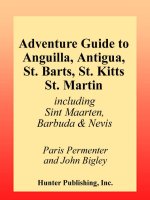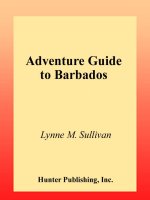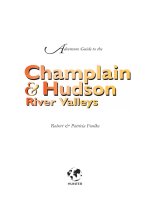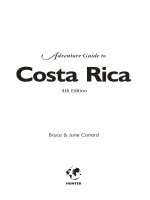- Trang chủ >>
- Khoa Học Tự Nhiên >>
- Vật lý
adventure guide to tampa bay and florida's west coast
Bạn đang xem bản rút gọn của tài liệu. Xem và tải ngay bản đầy đủ của tài liệu tại đây (3.01 MB, 323 trang )
Chelle Koster Walton
HUNTER PUBLISHING, INC.
130 Campus Drive
Edison, NJ 08818-7816
% 732-225-1900 / 800-255-0343 / fax 732-417-1744
Web site: www.hunterpublishing.com
E-mail:
IN CANADA:
Ulysses Travel Publications
4176 Saint-Denis, Montréal, Québec
Canada H2W 2M5
% 514-843-9882 ext. 2232 / fax 514-843-9448
IN THE UNITED KINGDOM:
Windsor Books International
The Boundary, Wheatley Road, Garsington
Oxford, OX44 9EJ England
% 01865-361122 / fax 01865-361133
ISBN 1-55650-888-3
© 2000 Chelle Koster Walton
All rights reserved. No part of this publication may be reproduced, stored
in a retrieval system, or transmitted in any form, or by any means, elec-
tronic, mechanical, photocopying, recording, or otherwise, without the
written permission of the publisher.
This guide focuses on recreational activities. As all such activities contain
elements of risk, the publisher, author, affiliated individuals and compa
-
nies disclaim any responsibility for any injury, harm, or illness that may
occur to anyone through, or by use of, the information in this book. Every
effort was made to insure the accuracy of information in this book, but the
publisher and author do not assume, and hereby disclaim, any liability or
any loss or damage caused by errors, omissions, misleading information or
potential travel problems caused by this guide, even if such errors or omis
-
sions result from negligence, accident or any other cause.
Maps by Lissa K. Dailey, © 2000 Hunter Publishing, Inc.
Illustrations by Joe Kohl
Indexing by Kathleen Barber
4321
Contents
Introduction 1
The History of Adventure 1
The People & Culture 3
Natural Makeup 5
Government-Protected Parks & Refuges 10
How To Use This Book 12
Information 13
Transportation 13
Weather/What to Pack 14
Sights & Attractions 16
Adventures 16
Where To Stay 22
Where To Eat 24
Nightlife 24
Tourist Information 25
Recommended Reading 25
The Nature Coast 29
Overview 29
Transportation 31
Information 32
Festivals & Events 32
Crystal River 33
Getting Here 34
Information 34
Sights & Attractions 35
Adventures 36
Shopping 38
Where To Stay 38
Where To Eat 39
Inverness 39
Getting Here 39
Information 39
Sights & Attractions 40
Adventures 40
Where To Stay 41
Where To Eat 42
Homosassa Area 43
Getting Here 43
Information 43
Sights & Attractions 43
Adventures 45
Where To Stay 46
Where To Eat 47
Withlacoochee State Forest 48
Getting Here 48
Sights & Attractions 49
Adventures 49
Where To Stay 52
Brooksville 53
Getting Here 53
Sights & Attractions 53
Adventures 54
Shopping 54
Where To Stay 54
Where To Eat 55
Weeki Wachee 55
Getting Here 55
Sights & Attractions 56
Adventures 57
Where To Stay 59
Where To Eat 59
St. Petersburg & Clearwater 61
Overview 61
Transportation 62
Information 64
Festivals & Events 64
Tarpon Springs & Dunedin 65
Getting Here 66
Information 67
Sights & Attractions 67
Adventures 70
Shopping 72
Where To Stay 73
Where To Eat 74
Clearwater & Clearwater Beach 75
Getting Here 75
Information 76
Sights & Attractions 76
Adventures 78
Shopping 81
Where To Stay 82
Where To Eat 83
Nightlife 84
Sand Key Communities 85
Getting Here 85
Information 85
Sights & Attractions 86
Adventures 88
Where To Stay 90
Where To Eat 91
iv
n
Tampa Bay & Florida’s West Coast
Treasure Island 91
Getting Here 92
Information 92
Sights & Attractions 92
Adventures 92
Where To Stay 93
Where To Eat 93
Nightlife 94
St. Pete Beach & Lower Islands 94
Getting Here 95
Information 95
Sights & Attractions 95
Adventures 96
Where To Stay 99
Where To Eat 100
Nightlife 101
St. Petersburg 102
Getting Here 102
Information 102
Sights & Attractions 103
Adventures 106
Shopping 108
Where To Stay 108
Where To Eat 109
Nightlife 110
Tampa 111
Overview 111
Transportation 112
Information 113
Festivals & Events 113
Downtown Tampa 116
Getting Here 116
Sights & Attractions 117
Adventures 119
Shopping 120
Where To Stay 121
Where To Eat 122
Nightlife 123
Ybor City 123
Getting Here 124
Information 124
Sights & Attractions 124
Adventures 126
Shopping 126
Where To Stay 126
Where To Eat 126
Nightlife 128
Contents
n
v
Northeast, Northwest & South of Tampa 128
Getting Here 128
Information 128
Sights & Attractions 129
Adventures 133
Shopping 136
Where To Stay 137
Where To Eat 138
Nightlife 139
Bradenton & Sarasota 141
Overview 141
Transportation 142
Information 143
Festivals & Events 144
Bradenton 145
Getting Here 146
Information 146
Sights & Attractions 146
Adventures 149
Shopping 152
Where To Stay 152
Where To Eat 153
Anna Maria Island 154
Getting Here 154
Information 154
Sights & Attractions 155
Adventures 155
Where To Stay 157
Where To Eat 158
Longboat Key 159
Getting Here 160
Information 160
Sights & Attractions 160
Adventures 160
Shopping 161
Where To Stay 161
Where To Eat 163
Lido Key & St. Armands Key 164
Getting Here 164
Sights & Attractions 164
Adventures 165
Shopping 166
Where To Stay 167
Where To Eat 167
Nightlife 168
Sarasota 168
Getting Here 168
vi
n
Tampa Bay & Florida’s West Coast
Information 168
Sights & Attractions 169
Adventures 172
Shopping 174
Where To Stay 175
Where To Eat 176
Nightlife 177
Siesta Key 178
Getting Here 178
Information 178
Sights & Attractions 179
Adventures 179
Where To Stay 180
Where To Eat 181
Nightlife 182
Nokomis Area 182
Getting Here 183
Sights & Attractions 183
Adventures 184
Where To Stay 187
Where To Eat 188
Venice 188
Getting Here 189
Information 189
Sights & Attractions 189
Adventures 190
Shopping 192
Where To Stay 192
Where To Eat 193
Charlotte Harbor 195
Overview 195
Transportation 196
Information 197
Festivals & Events 197
Manasota Key/Englewood 199
Getting Here 199
Information 200
Sights & Attractions 200
Adventures 202
Where To Stay 204
Where To Eat 205
Gasparilla Island & Out-Islands 205
Getting Here 206
Information 206
Sights & Attractions 206
Adventures 208
Shopping 210
Contents
n
vii
Where To Stay 210
Where To Eat 211
Port Charlotte & Environs 212
Getting Here 212
Sights & Attractions 212
Adventures 213
Where To Stay 214
Where To Eat 214
Nightlife 215
Punta Gorda 215
Getting Here 215
Sights & Attractions 215
Adventures 217
Shopping 219
Where To Stay 220
Where To Eat 221
Lee Island Coast 223
Overview 223
Transportation 223
Information 225
Festivals & Events 225
Cape Coral & North Fort Myers 226
Getting Here 227
Information 228
Sights & Attractions 229
Adventures 230
Where To Stay 231
Where To Eat 231
Pine Island & Out-Islands 232
Getting Here 233
Information 233
Sights & Attractions 234
Adventures 235
Where To Stay 237
Where To Eat 238
Fort Myers 239
Getting Here 239
Information242
Sights&Attractions242
Adventures245
Shopping247
WhereToStay247
WhereToEat248
Nightlife249
Sanibel&CaptivaIslands249
GettingHere250
Information250
viii
n
Tampa Bay & Florida’s West Coast
Sights&Attractions250
Adventures254
Shopping259
WhereToStay259
WhereToEat260
Nightlife262
FortMyersBeach262
GettingHere262
Information263
Sights&Attractions263
Adventures264
WhereToStay266
WhereToEat267
Nightlife267
SanCarlosPark&Estero268
GettingHere268
Sights&Attractions268
Adventures269
WhereToStay269
WhereToEat270
BonitaSprings&BonitaBeach270
GettingHere270
Information271
Sights&Attractions271
Adventures272
Shopping273
WhereToStay274
WhereToEat274
Naples&TheEverglades276
Overview276
Transportation278
Festivals&Events279
Naples280
GettingHere282
Information282
Sights&Attractions284
Adventures288
Shopping291
WhereToStay292
WhereToEat293
Nightlife295
MarcoIsland295
GettingHere295
Information297
Sights&Attractions297
Adventures298
WhereToStay301
Contents
n
ix
WhereToEat302
EvergladesCity&ChokoloskeeIsland303
GettingHere305
Information306
Sights&Attractions306
Adventures308
WhereToStay311
WhereToEat313
x
n
Tampa Bay & Florida’s West Coast
Acknowledgments
Many thanks to all who assisted me in the adventure of writing a Florida
adventure guide, especially to these helpful souls: Alisa Bennett, Kelly
Earnest, Joe Faulk, Nancy Hamilton, Beth Preddy, Frances Purvey, and
Wit Tuttell. I couldn’t have done it without you.
Dedication
To Rob and his fabulous Walton Adventures.
About the Author
Chelle Koster Walton began her greatest life adventure when she moved to
Sanibel Island sight unseen in 1981. She’s never looked back, except to
wonder why she didn’t move sooner. From her favorite island, the author
travels around Florida and the Caribbean researching guidebooks, of
which she has published eight, and writing magazine articles for Carib-
bean Travel & Life, National Geographic Traveler, Arthur Frommer’s Bud-
get Travel, Endless Vacation, New York Post, and other print and electronic
media. Walton is co-founder of www.guidebookwriters.com and a member
of the Society of American Travel Writers.
Introduction
F
or the purposes of this guide, the West Coast of Florida describes a slice
of coastline along the Gulf of Mexico beginning in the quiet rural set
-
ting of Citrus County, north of the Tampa Bay area, and ending in the
south at Naples and the utter wilderness of the Everglades. It encom
-
passes the coastal portions of Citrus, Hernando, Pasco, Pinellas, Hills
-
borough, Manatee, Sarasota, Charlotte, Lee, and Collier counties. This
region is cohesive in its types of vegetation and climate, yet it is infinitely
diverse.
The History of
Adventure
I
f you’re looking for adventure, you’re in the right place. West
Coast Florida, as one of the nation’s final frontiers, claims a his-
tory and heritage of rugged outdoorsmanship.
While the rest of the nation was busily traveling along paved roads and
buying their supplies from general stores, in the farthest corners of
Florida’s Gulf Coast – down Naples way and in the Florida Everglades –
folks were still trading with the natives for victuals and dredging enough
land out of the swamps to build the Tamiami Trail. The West Coast of
Florida was considered a wild, exotic place then, a place for safaris and
catching giant silver fish; a place where prehistoric turtles, alligators,
manatees, and horseshoe crabs thrived, where trees danced, birds dive-
bombed, dolphins smiled, flowers bloomed at night, and winter never
came.
n
The First Visitors
The first white men traveled to western Florida for adventure. And they
found it aplenty: half-naked natives, tricky waterways, impenetrable
swamps, and enough fowl and fish to thicken seas, sky, and fire-brewed
stews. In search of gold and youth, they chose to grumble, kill the natives,
and curse the rest. They brought their own hogs, cows, and citrus to eat,
then eventually left, discouraged by the persistent onslaughts from the
resident Amerindian tribes – the Calusa in the south, the Timucua
around today’s Tampa and Sarasota. Evidence of important Amerindian
centers of culture has been found in Marco Island, Mound Key, Pine Is
-
land, Useppa Island, Manasota Key, Terra Ceia, Safety Harbor, and Crys
-
tal River.
Introduction
Juan Ponce de León himself was the first recorded European to set foot
upon these shores, somewhere in Charlotte Harbor. Hernando De Soto
landed at today’s Fort Myers Beach or Bradenton, depending upon whom
you believe. Ensuing parties established forts, missions, and colonies at
Fort Myers Beach, Pine Island, and other strategic spots along the coast.
Legends fill the region’s early timelines with dastardly pirates who came
to prey upon ships sailing between the Caribbean and established towns
in northern Florida. Much has been exaggerated, particularly the legend
of Gasparilla, upon which a Tampa festival and a coastline attitude of
devil-may-care thrive. The mottled backwaters of the West Coast un
-
doubtedly harbor many a refugee from the law, but few as colorful as pub
-
licity agents have painted them.
More prevalent in the 17th through the 19th centuries were Spanish fish
-
ermen and gutsy farmers. Later, in the Charlotte Harbor area, commercial
fishing developed into a thriving industry. Fishermen lived in stilt houses
built on sand shoals from Placida to the Ten Thousand Islands. A handful
of the historic shacks remain.
In many ways, fishing settled the West Coast. Farming proved less de-
pendable, what with hurricanes and pests. Sugar plantations around
Bradenton and Homosassa came and went with the wind. In later years, a
reputation for great sportfishing brought well-heeled adventurers to the
coast, which eventually put the region on the map of the socially
connected.
n
The 1800s
In the meantime, war introduced others to this balmy, palmy land.
Florida, after being passed back and forth between Spain and England, be
-
came a US territory in the early 1820s. Shortly thereafter, Governor An
-
drew Jackson, to defend against the Seminole tribes he had angered, built
forts on Lake Holathlikaha near today’s Inverness, Tampa Bay, and the
Caloosahatchee River at today’s Fort Myers. Later, Civil and Spanish-
American War fortifications were built on Egmont and Mullet keys, at the
mouth of Tampa Bay. In the wake of war came ex-soldiers and their fami
-
lies. Then came industry and tourism.
St. Petersburg was built in 1887 as a health resort, and Tampa, formerly
Fort Brooke, gained a reputation as such. Railroads, cigar factories, and
hotels started the twin cities down the path to becoming the region’s met
-
ropolitan hub. Islands and coastal towns to the south remained the do
-
main of the intrepid. It wasn’t until big names such as Ringling and Edison
became associated with the region that people sat up and took serious
notice.
2
n
The History of Adventure
n
The 1900s to the Present
They came to fish. They came to swim in the warm, gentle Gulf waves.
They came to hunt, to escape, to winter. They came to stay. Since the
1940s, the coast’s population has built steadily. As more people came to re
-
side permanently, cities developed along typical lines, adding services and
culture to their slate of resorts, restaurants, and beachside facilities.
Adventure has always been part of what the coast offers. As eco-tourism
came into fashion, emphasis shifted to this aspect of vacationing. To the
fishing charters, tour boats, parasailing concessions, and Hobie Cat rent
-
als were added bike trails, sea kayaking, and nature-oriented tours. More
than any section of Florida, the West Coast has most firmly put its foot
down about wanton development. This makes it especially desirable for
adventurers seeking a return to what those first intrepid fishermen, hunt
-
ers, and sailors found.
Largely gone are the untamed lands and rugged lifestyles that attracted
adventurers a half-century ago. Still to be found throughout the region,
however, are areas and activities that retain the flavor and fervor of
Florida’s derring-do days.
The People & Culture
W
estern Florida has built its population in great part from tourists
who came and never left. The result is a rich blend of cultures.
n
The First Settlers
The first tourists arrived before history books, probably first from
Asia, later from South America and the Caribbean. The Calusa
and Timucua Amerindians did not survive the next incursion of
visitors. The Spanish eventually decimated their numbers with bows, ar
-
rows, and disease. Spanish influence persisted, and the area’s oldest fami
-
lies have names such as Padilla and Menendez, familial survivors from a
time when Cuban fishermen set up camps on the islands and Cuban cigar-
makers migrated from Key West.
Most of the latter settled in Tampa’s Ybor City. Germans, Italians, Jews,
and other nationalities, followed to work the cigar factories, making Ybor
City still today one of the region’s most colorful ethnic enclaves. The dis
-
trict is known for its restaurants where a Cuban sandwich or bowl of rice
and beans are culinarily symbolic.
Other early arrivals migrated from the north, among them the Seminole
Amerindians, a branch of the Creek tribe, whose bloodlines reflected an
intermingling of African and Spanish blood. The Seminole Wars forced
them to Arkansas, except for those who took cover in the Everglades’ for
-
The 1900s to the Present
n
3
Introduction
bidding wild lands. Seminoles and an offshoot tribe known as the Micco
-
sukee still live in the Everglades and on tribal lands around Tampa. In
the Everglades, most live in chickee huts, pole structures topped with in
-
tricately thatched roofs. The Native Americans subsist on fishing, farm
-
ing, and tourism, selling their colorful weaving, and raking in the proceeds
from bingo and gambling. The tribe runs casinos in Tampa, Miami and
Immokalee.
The Seminole Wars, and later the Civil War, further stocked the slowly
growing population with American soldiers who fell in love with the pleas
-
ant climate and lush surroundings.
FLORIDIOM: Settlers from Georgia and Ala
-
bama came to be known as “Crackers,” a term as
-
sociated with the region’s early cattle drivers,
who “cracked” their whips to herd wild cows.
Crackers contributed Deep South cuisine, folk
medicine, and a simple style of architecture
known as the Cracker house, which has come
back into fashion as “Old Florida” architecture.
They settled and farmed mostly in the interior
sections of the region, where to this day lifestyles
whistle Dixie and folks speak with “South in the
mouth.”
n
Northerners Arrive
Land booms of the pre- and post-Depression eras brought northerners
from far reaches. First came the well-to-do in search of adventures in the
untamed wilderness. Among them were President Teddy Roosevelt, Zane
Grey, Shirley Temple, Hedy Lamarr, Charles Lindbergh, Thomas Edison,
John Ringling, and Henry Ford. Giants from the industrial world followed,
often buying up land to insure the exclusivity of the region. They left be
-
hind a standard for nature appreciation and beautiful architecture. Oth
-
ers, such as Henry Plant and Barron Collier, saw the opportunity to
develop the land, and so built railroads, roads, ports, resorts, and hotels.
n
The Population Boom
Once the word got out, another sort of adventurer, known then as the “Tin
Can Tourist,” arrived in motor homes. They, and those that followed, led to
Florida’s reputation as an RV heaven.
4
n
The People & Culture
Much of Southwest Florida’s population in the past three decades came
from the Midwest, bringing along their meat-and-potatoes cuisine and
steady work ethics. At the onset of that era, retirees and seasonal resi
-
dents dominated the population. The late 1980s and early 1990s saw the
population homogenize somewhat, with folks coming from all parts of the
United States, all age groups, and all walks of life.
The Hispanic population is growing, as immigrants who had moved north
discover in West Coast Florida the sort of climate they once left behind in
their homelands. Cape Coral, one pocket of Hispanic ethnicity, enjoys the
celebrated cuisine and festivities indigenous to the culture. The town is
also known for its German and Italian populations.
Young families have found an ideal atmosphere for their children in West
Coast Florida – a playground open all year ’round.
Today’s West Coaster is said to have a calmer attitude than the East
Coaster – more like the Gulf than the ocean. Laid-back is the term most
commonly applied. The pace is slower, the surroundings more natural.
That’s where the generalities end. From the sophisticated Tampa metro-
polite to the Everglades backwoods Miccosukee, the West Coast embraces
a range of people as diverse as its terrain.
Natural Makeup
W
ith nearly 200 miles of Gulf coastline, more than 500 miles
of freshwater river, thousands of acres of lakes, mangrove
estuary, and untamed jungle, and the vast sawgrass plains of the
Everglades, Florida’s West Coast brims with opportunity for adventure on
both land and water.
The diversity of its terrain and biological communities, when combined
with the region’s exotic, subtropical climate and ambiance, creates a desti
-
nation that is both classroom and playground for outdoor enthusiasts.
Where else can you camp on a warm, sand beach and canoe among roseate
spoonbills and manatees?
n
Marine Life
The island beach and marine communities, of course, are the most touted
features of Gulf Coast Florida ecology. They introduce most visitors to the
local environment with their shells, dolphins, pelicans, shorebirds, sting
-
rays, tarpon, and loggerhead turtles; but they are only the beginning
point.
Marine Life
n
5
Introduction
In summer, stingrays nest along the shoreline in
shallow waters. To avoid stepping on them and
the excruciating pain that follows, locals do the
“Stingray Shuffle.” If you shuffle your feet as you
enter the water, the stingrays will gladly avoid
you. Punctures occur only when you step directly
on the ray’s barb.
n
Mangrove Estuaries
Most intriguing to nature lovers are the undersung estuaries, the nurser
-
ies that build islands and nurture aquatic life. Haunting, steamy places,
they harbor a species of tree that seems to dance on spindly legs – the man
-
grove. In its prop roots, dirt, barnacles, and other incrustations collect to
build shorelines and islands. Its leaf fall provides rich and fertile muck; its
branches, nests for local and migrating birds. Here the food chain begins
with the tiniest crabs and ends with the birds, fish, and manatees that
come to munch on seaweed or lunch on a half-shell. The cycle is ancient,
and one can sense that in the quietly regenerating world of the mangrove
estuary.
n
Flora & Fauna
Less brackish and freshwater systems are the domain of another ancient
component of Florida wildlife – the alligator. Gnarly and tyrannasaurish,
the American alligator survives and thrives in coastal rivers and particu-
larly in the Everglades. With it co-exist cypress trees, turtles, bass, river
otters, and fabulous birds such as the wood stork and great blue heron.
Salt marshes, scrublands, flatwoods, and high pine lands occupy different
elevations between sea level and ridge land. On hammocks, high and dry,
hardwood forests harbor the rarest of all Florida creatures, the panther,
seldom seen in the wild. Its cousin the bobcat is less reclusive, its
numbers less depleted. Black bears, white-tailed deer, squirrels, rac
-
coons, opossums, armadillos, and gopher tortoises roam the wood
-
lands. Get closer and you’ll find indigo snakes, anole lizards, skinks,
tree frogs, ant lions, and love bugs.
6
n
Natural Makeup
Some locals are less friendly than others. Those
you want to avoid include rattlesnakes, pygmy
rattlers, jellyfish, fire ants, and sand fleas (”no-
see-ums”). There are also noxious plants that can
pose danger, particularly the detested pepper
plant, an introduced tree whose berries can
cause allergic reaction. Poison ivy and oak grow
in the wilds. A mystery novel set on Sanibel Is
-
land describes murder by a different plant, the
oleander, a limb of which the murderer used to
roast a marshmallow for his victim.
Most native coastal plants are benign and serve to protect wildlife. Resi
-
dents are becoming aware of that and there is a trend to plant wildlife-
attracting gardens rather than exotic vegetation, which taxes the ecosys
-
tem. Cities, resorts, and commercial enterprises are using sea oats, rail
-
road vine, and other maritime vegetation to keep sands anchored to the
beaches. Native grasses attract gopher tortoises. Dead tree trunks pro-
vide homes for kestrels and other nesting birds, as well as food for pil-
eated woodpeckers. Butterflies flock around certain native plants, to
feed and lay their eggs.
On a larger scale, the region’s many state and national parks and refuges
began preserving habitat in its natural state back when land booms
threatened Florida’s fragile environment. Private enterprises have since
joined the drive to save what is dwindling. Today, these preserves offer not
only shelter to the threatened, but also recreation to those who appreciate
the region’s distinct environment.
n
Endangered/Threatened Species
Florida is home to more than 100 fragile species. Close to 40 of these are
listed on the US Fish and Wildlife Service list of endangered and threat
-
ened animals. Those found in West Florida include the Florida panther,
West Indian manatee, wood stork, bald eagle, red-cockaded wood
-
pecker, Florida scrub jay, roseate tern, American crocodile, Atlan
-
tic loggerhead turtle, Eastern indigo snake, and the sand skink.
n
Guidelines for Wildlife Preservation
While visiting Florida, take care to observe the following regulations and
guidelines for the protection of wildlife and habitat.
Endangered/Threatened Species
n
7
Introduction
SHELLING
n
Live shelling is prohibited in state and national parks, in ref
-
uges, and on all of Sanibel Island. In these areas, do not keep
any shell with an animal in it, whether or not you believe the
animal is dead. Gently return a live shell to the water; do not
fling it.
n
Lee and Collier counties limit live shelling to two per spe
-
cies per person per day.
n
Live shells must be cleaned properly or they will smell like
dead fish in a day or two. If you don’t know what you’re doing,
don’t collect the shells only to toss them from the car window
down the road.
n
A fishing license is required for collecting live shells in
Florida.
FEEDING WILDLIFE
n
Don’t feed wild animals. This includes everything from
those harmless seagulls on the beach to that very harmful alli-
gator behind the fence. Feeding alligators is illegal in Florida
and noncompliance is punishable by a hefty fine. More impor-
tantly, by feeding an alligator, you are teaching it not to fear
man. That’s when toddlers get grabbed off bank shores or fish-
ermen’s feet become ’gator bait.
n
Feeding birds on the beach not only causes a nuisance, it
again overrides their instincts and the birds forget how to feed
themselves.
n
Do not throw fish to pelicans, no matter how much they
beg and how adorable they are. Large bony fish can cause bill
and throat punctures. Be careful when you cast around gath
-
ered pelicans. They often swallow bait, hook and all. If this hap
-
pens, gently reel in the bird, cover its head with a towel or
shirt, and carefully clip and extract the hook, trying to back it
out rather than running the barb through the bird’s skin.
n
If you’re camping or picnicking, you may find yourself inad
-
vertently feeding raccoons and squirrels. At night, put all of
your food, including supposedly sealed coolers and bags of
garbage, inside a vehicle or trash bin.
8
n
Natural Makeup
HARMFUL LITTER
n
Discarded fishing filament, plastic shopping bags, and bever
-
age six-pack rings can harm pelicans and marine life. Toss litter
into a trash receptacle.
n
Be careful not to throw food or food wrappers out the car
window. This attracts animals to roadways, where they can be
run over.
SEA TURTLES
n
Loggerhead turtles come to nest on our beaches during the
summer. Do not disturb their nests, which are marked by tur
-
tle night patrols. Turn off lights facing the beach; they disorient
nesting and hatching turtles.
MANATEES
Watersports enthusiasts play a major role in the continued endan-
germent of the Florida manatee. To ensure the survival of these
loveable creatures, please abide by these guidelines.
n Use snorkel gear when diving with manatees. Scuba gear
bubbles can frighten them.
n
Never feed a manatee in the wild.
n
Never approach or chase a manatee.
n
Never separate a cow from her calf.
n
Do not touch manatees. Never poke, prod, or stab a mana
-
tee with your hands, feet, or any object.
n
When boating, wear polarized glasses that permit you to
see surfacing manatees better. Stay in the center of marked
channels and out of seagrasses. Observe manatee speed zones
and drive slowly enough to be able to see and avoid a manatee.
n
To report a manatee death, injury, harassment, or radio-
tagged manatee, call % 800-342-5367. For more information,
see the Florida Fish & Wildlife Conservation Commission’s
Web site at www.state.fl.us/fwc/psm/manatee/guide.htm or
www.state.fl.us/fwc/psm/manatee/manatee.htm.
Everglades National Park
n
9
Introduction
BOATING & FISHING
n
Observe manatee zone signs by slowing down to no-wake
speed. Take the slack time to watch for the fascinating mam
-
mals as they surface for air.
n
Stay in the marked channels when boating. This not only
protects you and your vessel, but also the fragile grass flats
that feed our fish.
n
Most local guides and fishermen practice catch-and-release,
and will urge you to do so as well. Certain fish, such as tarpon,
require a special permit to kill.
VEGETATION
n
It is illegal to pick sea grass, which keeps our beaches in
place. Mangroves are also protected by the law; don’t trim or
cut them down.
Government-Protected
Parks & Refuges
T
he region’s most extensive refuge lands, in Everglades Na-
tional Park, were saved from disaster as they balanced on the
brink, thanks to the efforts of Marjory Stoneman Douglas. Her
book entitled The Everglades: River of Grass,published in 1947, sparked a
movement to convince the federal government to preserve the fragile wet
-
lands.
n
Everglades National Park
The Florida Everglades and their accompanying Ten Thousand Islands
cover 2,100 square miles and have 99 miles of canoe trails, 600 types of
fish, 350 species of birds, 60 species of amphibians and reptiles, 45 species
of mosquitoes, and 25 species of mammals. This guide covers the portion of
the massive park that lies in Collier County and is accessible from the west
– the part that includes Ten Thousand Islands.
Sharing the Everglades ecology, Big Cypress National Preserve, Faka
-
hatchee Strand State Preserve, and Collier Seminole State Park of
-
fer a score of eco-opportunities in the vicinity.
10
n
Government-Protected Parks & Refuges
n
National Wildlife Refuges
Another national preserve in the region takes up half of Sanibel Island.
J.N. “Ding” Darling National Wildlife Refuge is also Everglades-like
in its wetlands makeup. Egmont Key National Wildlife Refuge occu
-
pies the entire 398 acres of Egmont Key, which is approachable only by
boat. So is the Pine Island National Wildlife Refuge, comprising out-
islands in Pine Island Sound. In the coast’s northern reaches, the Chassa
-
howitzka and Crystal River National Wildlife Refuges and the
Withlacoochee State Forest preserve the pristine waters and forests of
Citrus and Hernando counties.
n
Marine Preserves
Much of what attracts adventurers to the region lies off briny shores, in the
Gulf of Mexico, the world’s largest gulf, or in the Intracoastal Waterway of
bays and harbors between mainland and barrier islands. Within the area
we will be covering lie two of Florida’s largest inlets: Tampa Bay and
Charlotte Harbor. The 7,667-acre Cape Haze Aquatic Preserve in
Charlotte Harbor protects precious marine resources. The long Caloosa-
hatchee River provides watery passage between the Gulf and the great
Lake Okeechobee. The shoreline north of Tampa Bay is riddled with river
mouths and marshlands that front them. Other West Coast sea preserves
include the Pine Island Sound Aquatic Preserve and Estero Bay
Aquatic Preserve.
n
State Parks & Historic Sites
Florida maintains an excellent system of state-operated parks, historic
sites, and other recreational areas. This book covers several of the finest,
from the unbridged island refuge of Cayo Costa State Park to the un
-
usual slice of nature and history preserved at Koreshan State Historic
Site and the 30-foot Indian mound in Crystal River State Archaeologi
-
cal Site. Many of the parks provide recreational opportunities that allow
visitors to play while immersing themselves in nature and history.
If you plan on exploring the parks to any extent,
consider purchasing an annual pass for $40 ($80
for families), available at the entrance booth to
most of the parks or by calling % 352-628-7002.
Visit the Florida State Parks Web site at www.
dep.state.fl.us/parks/.
National Wildlife Refuges
n
11
Introduction
How To Use This Book
T
his book divides the West Coast into seven sections. It begins in the
north with Citrus and Hernando counties, a region dubbed the Na
-
ture Coast. It then continues southward with St. Petersburg & Clear
-
water, covering an area known in tourism jargon as the Suncoast. The
chapter encompasses Tarpon Springs, Clearwater, St. Petersburg, and the
adjacent barrier island chain.
Tampa, as metropolitan core of the West Coast, has its own chapter; then
we move south to Bradenton & Sarasota, with their islands and the
town of Venice.
The little-known Charlotte Harbor area has one chapter. Then we cover
Lee County, promoted as Lee Island Coast, from Fort Myers south to its
famous island pair, Sanibel and Captiva.
Collier County, one of Florida’s largest, includes its main town and govern
-
mental seat, Naples, as well as Marco Island, Ten Thousand Islands,
Everglades City, the western half of the Florida Everglades, and its sur-
rounding parks and preserves.
Each chapter begins with a brief overall history and information that will
make finding your way around easier. Then it is divided by cities or areas
within the sub-region, their adventure opportunities, sights, restaurants,
hotels, and other attractions. Sprinkled amid the hard facts, you’ll find
budget tips, author recommendations, family-friendly choices, quirky
Florida terms, and weekend adventure itineraries.
12
n
How To Use This Book
Information
Transportation
n
By Air
If you are traveling by air, five international airports and various
local runways serve your needs. Tampa has the largest interna
-
tional airport; others are located in St. Petersburg, Sarasota-
Bradenton, and Fort Myers. Orlando International Airport is also
convenient to the Nature Coast (Citrus and Hernando counties). Major do
-
mestic airlines serve all five. International flights arrive principally from
Canada, Germany, and the United Kingdom. Each chapter gives specific
airport and airline information.
n
By Car
Motorists make inroads on Interstate 75, the coast’s zippy north-south
artery, and Interstate 4, which hits Tampa from the east, connecting it to
Orlando. Highway 41 (Tamiami Trail) and Highway 98 provide more lei-
surely ways to explore the coast. Florida’s Turnpike is the main artery
between Orlando and the Nature Coast. In winter’s high-season, traffic
can get a bit frustrating through towns that seem to grow together at the
seams, especially on “The Trail.” Yet it, the coast’s earliest land route, has
a story to tell, if you take the time to stop, look, and listen.
Florida has a seat belt law, so buckle up. If your
car or your rental is equipped with a passenger
side airbag, make sure you seat young children
in the back. Airbag ejection can kill tots. Florida
law also requires that children up to age three be
restrained in an approved child safety seat. Ages
three and older can use the automobile manufac
-
turer’s installed restraint system. The state rec
-
ommends placing infants to three-year-olds in
the back seat and positioning them in the car’s
center.
Informatoin



![raffauf - plant alkaloids - a guide to their discovery and distribution [dp] (fpf, 1996)](https://media.store123doc.com/images/document/14/ri/yi/medium_yip1396501903.jpg)





